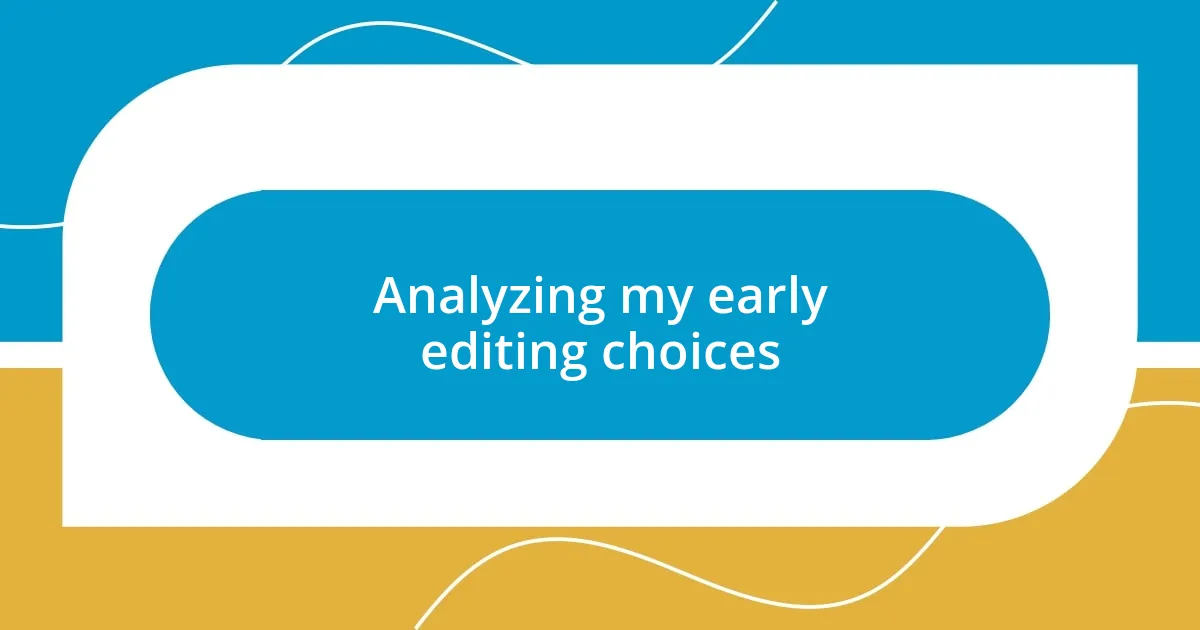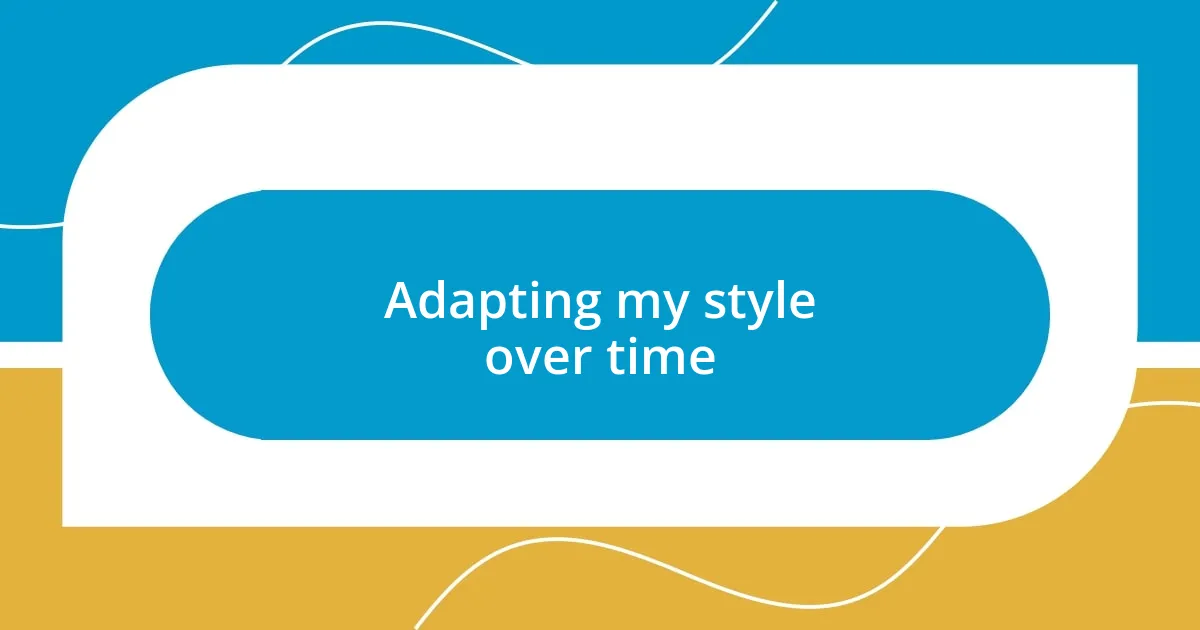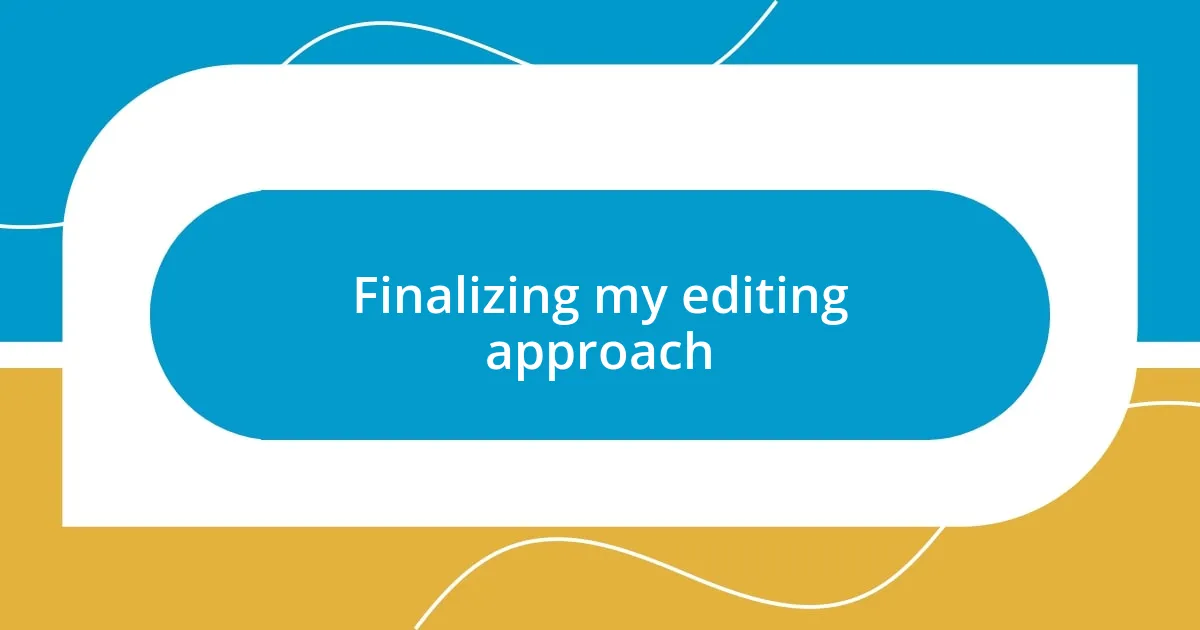Key takeaways:
- Editing is not just about correcting mistakes; it involves enhancing clarity, flow, and the reader’s experience.
- Exploring different editing styles, such as minimalist and comprehensive, can lead to a unique personal voice while improving effectiveness.
- Feedback from peers and audience insights are invaluable for refining editing approaches and preserving the authenticity of the work.
- Adapting one’s editing style over time blends intuition with technological tools, emphasizing emotional resonance and storytelling to engage readers.

Understanding editing fundamentals
Editing fundamentals are crucial, serving as the backbone of any polished piece of writing. I remember my first major editing project, where I was overwhelmed by the sheer amount of content. It was a steep learning curve, but it taught me that clarity comes from structure, and that’s something I still prioritize today.
One of the key elements in editing is understanding the purpose of each piece. I often ask myself, “What message am I trying to convey?” This question not only anchors my editing process but also allows me to identify areas that need refinement. When I focused on the intended message, I found that even small changes could create a significant impact on how the audience perceives the work.
Additionally, I’ve learned that rhythm and flow are vital components in editing. I liken it to music; just as a song has a beat that guides the listener, a well-edited piece has a pace that keeps the reader engaged. During a recent edit, I rearranged a few sentences to create a smoother transition, and the difference was astounding. It reminded me that editing is not just about correcting mistakes; it’s about enhancing the reader’s experience.

Exploring different editing styles
Exploring different editing styles can be an eye-opening experience. I remember the first time I experimented with a minimalist editing approach. At first, it felt counterintuitive to cut out so many words, but what emerged was a clarity that made my writing resonate more powerfully with readers. The beauty of this style lies in its simplicity; it strips away the excess, focusing on what’s truly essential.
Conversely, there’s the comprehensive editing style, which involves detailed attention to every aspect of the text. I recall working with a colleague who meticulously combed through each paragraph, questioning every word choice. Initially, I found it tedious, but over time, I learned the value of this thoroughness. It reinforced the importance of nuance and the impact of each design element, transforming my perspective on what comprehensive editing could offer.
Ultimately, the richness of editing styles is what makes our work so diverse and engaging. By combining different approaches, I’ve discovered a unique style that resonates with my personal voice while enhancing the reader’s experience. This evolving journey is both exciting and essential since it allows me to continually refine my craft, adapting to different projects and audiences.
| Editing Style | Description |
|---|---|
| Minimalist | Focuses on brevity and clarity, cutting unnecessary words for a concise message. |
| Comprehensive | Involves detailed scrutiny of every text element, ensuring nuance and depth. |

Analyzing my early editing choices
As I reflect on my early editing choices, I can’t help but chuckle at how misguided I sometimes was. One particular instance stands out: there was this article I edited, and I was so eager to polish it that I ended up over-editing. The original voice was lost in my quest to make everything “perfect.” This taught me an essential lesson about preserving authenticity while still refining content.
- I learned that each piece carries its unique voice, which I must respect.
- I discovered that less can indeed be more; sometimes, the magic lies in what you don’t change.
- I realized that editing is a balancing act, requiring both intuition and technique.
In the beginning, my focus was often primarily on grammar and structure. However, over time, I started questioning whether I was truly capturing the essence of each piece. One memorable moment was when I revised a friend’s heartfelt story and became so engrossed in fixing the technical aspects that I lost sight of the emotional core. It was a wake-up call that it’s not just about fixing errors—it’s also about preserving the message.

Experimenting with unique techniques
Diving into unique techniques was a turning point for me. I’ll never forget when I decided to try my hand at color-coded edits. Initially, it felt a bit unconventional, but visually categorizing my feedback helped me see patterns in my writing that I hadn’t noticed before. Have you ever colored your notes? It’s like seeing your creative process come alive in vibrant shades. This method made me more aware of my habitual errors and encouraged me to venture into unfamiliar territories.
There was a time when I dabbled in reverse editing. Instead of starting from the beginning of the text, I approached it by reading the last sentence first. This technique revealed the flow of ideas in a whole new light. Strangely, I found this backward glance sharpened my analytical skills, enabling me to refine my arguments more effectively. By flipping the narrative on its head, I gained a unique perspective that challenged my typical editing routine.
One of my most memorable experiments was incorporating reader feedback directly into my edits. I remember posting an article online and inviting readers to share their thoughts. Their insights transformed my approach, showing me where I tended to misunderstand my audience. It was a humbling experience; have you ever felt that spark when collaborating with others? This technique not only improved my editing but also deepened my connection with those I aimed to reach.

Receiving feedback from peers
There was a time when I nervously shared my edits with a small group of peers, hoping their feedback would help me grow. The moment I received a critique that felt a bit harsh, I had a choice to make: either take it personally or view it as an opportunity to improve. I chose the latter, and honestly, that shift in mindset opened up a whole new world of learning for me.
One particular experience comes to mind: after sharing my work with a fellow editor, they pointed out the areas where I frequently overlooked subtleties in tone. At first, it stung, but reflecting on their insights transformed my approach to editing. Their feedback became a guiding light, helping me notice the delicate layers within a piece that I might have otherwise glossed over. It made me wonder—how many other nuances have I missed in my eagerness to correct?
I’ve also learned that feedback isn’t just about the red ink; it’s a conversation. I remember a peer suggesting a collaborative editing session, where we discussed our different approaches. It was eye-opening to see how others framed their critiques and shaped their edits based on personal experiences. Have you ever felt the thrill of bouncing ideas off someone and watching a piece evolve in real-time? It’s in those moments that I realized the true value of peer feedback lies not just in the notes on the page but in the relationships we build along the way.

Adapting my style over time
Adapting my editing style over time felt like navigating a winding path rather than sprinting in a straight line. I distinctly remember a phase where I immersed myself in the world of minimalist editing. Initially, my instinct was to dissect every sentence, but I learned that less can truly be more. Have you ever stripped down a piece to its essence and felt the power surge through its simplicity? It was a revelation that taught me to prioritize clarity and impact over complexity.
I also embraced technology to refine my editing style. I began using editing software, which offered features I hadn’t considered before, like readability scores and style suggestions. At first, I resisted the idea of letting a machine guide my creativity, but then I realized these tools could enhance, rather than dictate, my decisions. How often do we let technology foster our growth rather than inhibit it? By tweaking my approach to integrate these digital assistants, I found a harmony between instinct and structure that truly refined my editing process.
My style didn’t just transform through techniques; it grew alongside my experiences. After writing an article on a topic I was passionate about, I felt an exhilarating connection with my readers, which prompted me to adjust my focus. I could see where emotional resonance affected engagement, so I shifted my editing lens to emphasize storytelling elements. Isn’t it fascinating how feedback from our audience can reshape our craft? This evolution wasn’t just about polishing sentences; it became an ongoing dialogue with my readers, enriching both my style and their experience.

Finalizing my editing approach
Finalizing my editing approach was a multifaceted journey, a mosaic of lessons learned through practice and exploration. One vivid memory stands out: sitting at my desk late at night, pouring over a piece I had edited for hours. I stared at the screen, feeling that something was still off. In a moment of frustration, I decided to read it out loud. To my surprise, I discovered awkward phrasing and didn’t quite capture the intended voice. That simple act clarified my editing style, reinforcing how essential it is to experience the text as a reader would. Have you ever experienced that revelation when a small shift in perspective yielded significant insight?
Mentoring under an experienced editor was another transformative experience. I vividly recall our first editing session together when she suggested I step back and assess the bigger picture before diving into details. It felt counterintuitive at first. However, as I practiced this approach, I realized that each edit served a greater purpose in enhancing the overall narrative. The value of this insight truly hit home during a collaborative project—it was like a lightbulb flicked on, illuminating how my cohesive editing could shape the final outcome. Isn’t it remarkable how mentorship can invite us to reconsider our process?
Moreover, I began to embrace the role of intuition alongside my analytical skills. I remember a time when I instinctively knew a paragraph didn’t quite fit but couldn’t justify my feelings with hard edits. Instead of forcing logic into it, I trusted my gut and revised until it felt right. This experience taught me that editing isn’t just about adhering to rules; it’s also about fostering a connection with the piece and invoking the emotions I want to elicit in my readers. Do you trust your instincts when you edit, or do you often second-guess yourself? Finding that balance between analytical rigor and emotional engagement has become a cornerstone of my final editing approach.














